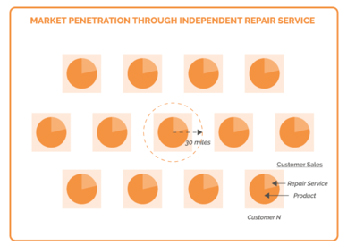Entry in the small-customer
A national distributor of lift trucks needed to expand plant capacity for its operations. While industry growth was flat in a mature industry, the company was constrained by its current capacity and needed to expand. Looking ahead, management was not sure whether the level of market demand was sufficient to warrant building a new plant, but current operations were constrained.
As a first step, we determined that demand in the company’s segment did not justify building additional capacity. However, we found that the small-customer segment was served by many fragmented suppliers and was underserved in maintenance and repair operations (MRO).
As a result, we devised a penetration strategy to grow sales organically in the small-customer segment based on the following points:
- Hire salesmen to cover market fully and sell to small customers
- Establish a network of maintenance facilities through independent repair shops to offer MRO services
- Deploy new sales team nation-wide to sell to small customers across the entire market
- Stage an aggressive marketing campaign based on TV and radio advertising, social media, telemarketing, periodic e-mailing campaigns, personal sales force visits
- Conduct Marketing & Sales and MRO service for at least two years before building the plant
In the next two years, the client grew at 8% per year and reached the sales volume needed to build a new plant.
Forecasted demand and determined that the current segment was insufficient to justify additional capacity
DEMAND FORECASTING
- Estimated demand by product and by customer
• Products lines are categorized by tonnage of displacement, including: 0 to 2 tons, 2 to 3 tons, 3 to 10+ tons
• Customer segments include: small (0 to 5 vehicles), medium (5 to 50 vehicles), large (50 to 100+ vehicles) - Derived demand from demand of driver industries, including: automotive, steel, food retail, non-food retail, agribusiness, construction, industrial chemicals, printing, wood, textiles
- Estimated growth potential for lift trucks within each segment (customer x product) by industry
ESTIMATION OF SUPPLY AND DEMAND
- Estimated demand growth and accessible market share
- Based on supply and demand estimates, concluded that future level of sales volume based on head-on competitive selling would be insufficient to justify additional capacity.
AFTER MARKET FOCUS
Studied the after-sales market
- Assessed purchase patterns and existing contracts across competitors
- Determined that the company would not be able to gain sufficient traction in selling after-sales contracts to customers (large, medium, small)
TARGETED SMALL CUSTOMERS
Studied the small-customer segment
- Found that the segment was highly fragmented, (40,000+ customers), profitable, and growing at 15%.
- Drivers of fragmentation were the following:
• sales based on local image, ensuring local presence to respond to MRO needs
• greatest tolerable distance away from shop was 30 miles
• need for on-site repair as customers required (1) highly personalized attention in MRO, and (2) would not ship lift trucks away
• absence of economies of scale in setting up concessionaires
ORGANIC GROWTH
Devised a penetration strategy targeted at small customers. The strategy focused on the following fronts:
- Offering highly-customized MRO services
- Services were rendered locally through a network of independent repair shops.




